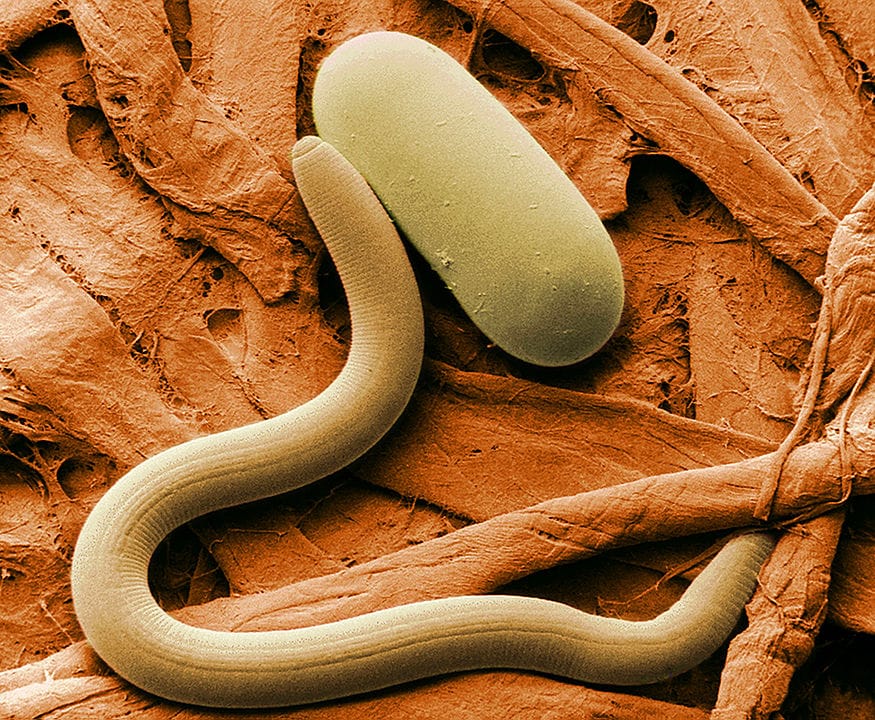SCN accounts for more than $1 billion in losses for U.S. farmers annually and has moved into Canada. Recent discoveries are helping to reverse the damage.
Being a farmer is not for the faint of heart. The industry has long faced great challenges that don’t seem to be going away anytime soon. Everything from climate change to increasing costs related to supplies, labor and fertilizer. And, let’s not forget crop diseases, one of which is showing greater resistance more than ever — soybean cyst nematode (SCN).
As one of the largest field robbers, SCN has been devastating to soybean crops across the U.S. and is now starting to move across Canada. While SCN can often cause more than 30% yield loss in some affected soybean fields, the good news is that in the past year, new discoveries and technology have been released to combat it with encouraging results.
But first, what is soybean cyst nematode? The University of Illinois at Urbana-Champaign called it one of the most destructive pests quite unlike its worm relatives. While the vast majority of nematodes appear as microscopic worms, the female SCN can essentially shape shift into a tiny lemon after feasting on soybean roots. This round shape allows the female to retain approximately two-thirds of its fertilized eggs, so as the embryos develop, the host’s body hardens to become a protective cyst. This has allowed SCN to be as damaging as it is.
Labs across the U.S. are still looking at how to minimize SCN damage. One such lab includes Iowa State University’s Greg Tylka, professor in the Department of Plant Pathology and Microbiology which has extension and research responsibilities for management of plant-parasitic nematodes. Research in his lab includes field experiments assessing the yield protection and control provided by SCN-resistant varieties and by nematode-protectant seed treatments.
His graduate students are conducting laboratory experiments to determine how nematode-protectant seed treatments affect specific aspects of the biology of SCN, things like hatching, movement, response to chemical stimuli, and more.
Tylka says SCN is widespread and is estimated to reduce soybean yields in North America by $1.5 billion annually.
“All soybean-producing areas of the U.S. and Canada are prone to have SCN. New fields and counties are found to be infested with SCN every year,” he says. “On a field scale, the yields of soybean varieties with ineffective but extremely common SCN resistance genes from a breeding line called PI88788 can be 22 bushels per acre less than yields of soybean varieties developed with the uncommon, but effective SCN resistance breeding line called Peking. At $9 beans, 22 bu/ac is a $200 per acre yield loss and with $17 soybeans, it’s $374 per acre yield loss. This is staggering!”
Unfortunately for growers, there typically isn’t any visible, above ground damage due to SCN says Jeremiah Mullock, product manager of seed treatment at BASF’s Triangle Park, North Carolina, one of largest chemical producers in the world.
“Despite being a large contributor to yield loss, there are often no above-ground symptoms to SCN,” he says. “The main protection against SCN has relied on native traits. However, the nematode is becoming resistant to a main resistance source (PI88788) leading to additional yield loss and increased nematode populations.”

Seven Decade History
While SCN is a pest that is not native to the main soybean growing area in the central part of the U.S., it was brought here in the mid-1950s from seeds outside the country and has been a yield-robbing pest ever since.
“SCN was first detected in 1954 in North Carolina and has since been moving northwards up to Canada,” says Jeff Kaiser, seed treatment technical services manager at Nufarm. The company — established in Australia more than 100 years ago — is a leading global manufacturer and supplier of crop protection and seed treatment.
“Current defense options within the soybean plant — which include the PI88788 and Peking gene — were some of the early defense mechanisms available in soybean varieties. These traits provided acceptable levels of protection in soybean production when the targeted APH for soybeans was in the 50-bushel range. Today the traits available are not enough protection for the soybean seed in today’s yield environment.”
Kaiser adds that early awareness programs in 2010 have increased awareness in areas of soybean production impacted by SCN pressures. Also, seed treatment products that are biological in type have entered the market and exited the market due to poor consistency in performance and treating challenges.
“Currently, there is also a chemistry-based product that protects the soybean crop that has some crop tolerance concerns in cool conditions and when used in combination with a class of pre-emerge herbicides for soybeans.”
What Will Help?
While this is a tough problem, there are treatments that are proving to be very helpful. For example, Nufarm released Trunemco, a nematode management seed treatment that provides excellent protection to the soybean plant against SCN. This product provides the soybean plant with protection by activating the plant’s natural defenses as soon as the seed germinates, thereby providing crucial early protection.
“The two modes of action within Trunemco allow for early protection without slowing the plant metabolism, supporting vigorous early growth. And, secondly, Trunemco colonizes around the newly formed soybean root for continued protection against soybean cyst nematode,” explains Kaiser.
“This material’s patent was approved with the EPA in 2019. Trunemco’s low-use rate aids in its ease of use when added to current soybean seed treatment blends. The Trunemco label states a caution signal word that makes it fit into a user-friendly platform when handling.”
At BASF, Mullock says the ILEVO seed treatment his company offers provides protection to the roots against SCN to inhibit egg hatch, kill juvenile SCN, and decrease reproduction.
“ILEVO delivers 2-4 bu/A yield increase above a base fungicide and insecticide seed treatment on a variety containing PI88788 native resistance.”
In addition to this, some encouraging news was announced in late June by BASF, Corteva Agriscience and MS Technologies. The three companies have entered into a mutually beneficial trait licensing agreement to develop next-generation Enlist E3 soybeans with the nematode resistant soybean (NRS) trait for farmers in the U.S. and Canada.
In a recent press release, it was announced that Corteva and MS Technologies have licensed the Enlist E3 soybean trait to BASF for development with the NRS trait in BASF germplasm. BASF has licensed its NRS trait to Corteva and MS Technologies for use in Enlist E3 soybeans. The three companies anticipate commercialization of Enlist E3 soybean varieties containing the NRS trait in the late 2020s, pending applicable regulatory reviews and completion of field testing.
“Our nematode resistant soybean trait will be the first commercially available biotechnology trait developed to control nematodes,” says Linda Trolinder, senior vice president of BASF Seeds and Traits R&D. “BASF is in its 5th year of advanced field testing the NRS trait in the U.S. and in our trials, it has demonstrated an average 8% yield benefit above today’s SCN-resistant varieties.”
The Enlist weed control system is an industry-leading system for soybeans, corn and cotton. Enlist E3 soybeans are tolerant to 2,4-D choline, glyphosate and glufosinate herbicides, giving farmers additional options to manage resistant and hard-to-control weeds.
“Farmers have embraced the Enlist E3 soybean trait, which offers maximum flexibility among the industry’s various weed-control systems,” adds Tim Glenn, executive vice president, Seed Business Unit, Corteva Agriscience.
“The addition of the NRS trait to Enlist E3 soybeans is a logical next step for Corteva. Offering both trait technologies together will provide soybean farmers with additional functionality for pest management.”

The Near Future
As for what the next three to five years holds in the fight against soybean cyst nematode, Tylka says he expects SCN to continue to cause tremendous soybean yield loss throughout North America.
“That’s because SCN populations throughout the U.S. and Canada will continue to build up the ability to reproduce on soybean varieties with the PI88788 source of resistance genes, which is in about 95% of all SCN-resistant varieties in the U.S. I also expect more nematode-protectant seed treatments to appear on the market. Nematode-protectant seed treatments will somewhat dampen SCN yield loss on soybean varieties with PI88788 SCN resistance, but nowhere near enough to completely offset the yield loss caused by SCN on soybean varieties with PI88788 SCN resistance.”
Kaiser concurs and says we can expect to see the rise in SCN continue, but by taking both hard-wired resistance and layering additional seed treatment protection, growers will be able to maximize their genetic potential.
“As the dollar per bushel goes up, the economic threshold is lowered. Therefore, we‚Äôve found the ROI of the additional on-seed nematode protection can be in excess of 3:1 in high-pressure situations.”
Adds Mullock, “SCN will continue to be a major threat to soybean yields and it is important that an integrated approach to managing this pest is started now and continues. SCN populations can be managed with the available tools, including native traits, seed treatment, crop rotations, and new trait innovations, to maintain high soybean yields.”
Want to read more from September Seed World? Check out:
Seed World Announces 2022’s Top 10 Next Generation Leaders
Magan Lewis Creates Sparks in Those Around Her












